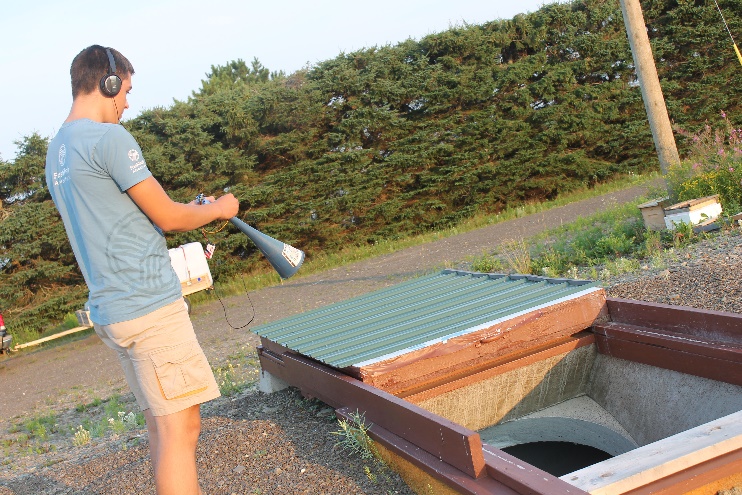

Honey bees and other pollinating insects are critically important to ensuring long term biodiversity as well as global food security. Many flowering plants and crops depend on honey bees for reproduction and growth. But due to a variety of factors from climate change to pesticide usage, their numbers are on decline.
Given the many variables in the natural world, it can be hard to pinpoint the exact changes or factors in an environment that could be impacting honey bees before it’s too late. To enable research in a more controlled environment, the Honey Bee Research Institute and Nature Center in Saint David, Maine has created a wind tunnel to introduce a controlled flow of air and measure a baseline or normal insect flight response for entire hives of bees.
Researchers then hope to measure changes to insect vitality after introducing a suspected agent of stress, or administering a treatment of potential benefit. The institute is currently evaluating a number of different approaches to measuring how different factors affect bees individually or across a population, facilitated in part with Tektronix instrumentation.
As part of the Tektronix Education Support Program, Tektronix recently helped the Honey Been Institute obtain a Keithley 2182A Digital Nanovoltmeter. The 2182A Nanovoltmeter is ideal for measuring low voltages such as those found on insects. It can sense voltages as low as 1 nanovolt or 10-9 volts. The 2182A is found in many research labs around the world, used by researchers involved in technologies such as superconductors, materials research, nanotechnology, and biology.
As shown in the photo below, the institute is also using a Tektronix TBS1052B-EDU oscilloscope. The institute sponsored a 2014 summer intern from a northern Maine area high school, to solder up a simple vibration analyzer and couple this sensor to vibrations formed from audio output at various locations on a speaker activated by a simple square wave generator. The electrical output of the vibrations are then detected by light produced in an illuminated LED, and the LED is also being tapped by probes to view the waveform shape and frequency on the oscilloscope. The speaker vibration source acted as a prototype to sense the vibrations of a beehive or to measure a single bee held in a test fixture.

The Honey Bee Research Institute is evaluating methods for determining how stress factors impact honey bees using a Tektronix oscilloscope.
In another test, the oscilloscope is used to graph the audio signals generated by a single bee captured inside a covered petri dish using a sensor microphone placed under the dish. In addition, as shown in the photo below, a microphone amplifier is used to listen in on entire honey bee hives that are placed inside the insect wind tunnel test chamber.

A microphone amplifier is used to listen in on honey bee hives that are placed inside the wind tunnel test chamber. The large door pictured can be used to temporarily seal the testing chamber.
Peter Butzloff, Ph.D. and president of the Honey Bee Research Institute outlined other approaches the institute is pursuing:
“Our next step is to design a test fixture to hold a living bee, and then measure the bee wing vibrations arising from trial and error tests to determine some best attachment point to a bee using the vibration analyzer output to the oscilloscope. We will also provide a second channel of input to the oscilloscope from a microphone and amplifier, sending both of these signals to the oscilloscope for comparison of channel 1 and channel 2. We will store and compare data from these two methods of measuring bee-generated waveform and frequency of wing vibrations, onto a computer spreadsheet for a more detailed numerical analysis.”
Dr. Butzloff continued:
“Eventually, we hope to stimulate test bees with odors, tastes, or smells that may cause them to exhibit measurable changes in various possible sensors used to detect biological electrical voltages, buzzing and wing vibration, or motion and electrostatic friction effects. The Keithley nanovoltmeter is being used to determine relative electric potential differences between contacted points on the body of the bee. We also compare sensors suited to electrostatic analysis including a Faraday Cup for total charge measurement, and various non-contact (vibrating) reed electrostatic voltmeters.”
Understanding and mitigating the factors leading to the decline of honey bees is critical to maintaining our food supply and supporting diverse plant life around the world. The work being performed by the Honey Bee Research Institute may well lead to important breakthroughs. The Honey Bee Research Institute and Nature Center, Inc. website is www.brinc.org. Contact them at [email protected].


